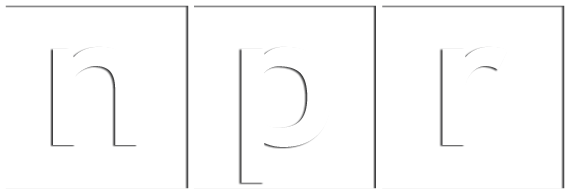This Is Color
A Weird Little Lesson, In Rainbow Order
by Nicole Cohen and Beth Novey
Oct. 23, 2014
Remember Roy G. Biv?
When you’re little, you spend a lot of time thinking about colors: You have favorite colors, and you learn about Roy G. Biv — that little mnemonic to help you remember the order of the rainbow.
But there are things you maybe didn’t learn from your grade school teachers and their slide projector presentations, like why the Simpsons are yellow or that there is, in fact, a word that rhymes with orange.
As part of NPR’s forthcoming series on color, we’ve compiled some surprising #colorfacts into a weird little lesson, with visuals inspired by the 1950s work of professor Arthur C. Hardy of MIT.
Interested in a musical accompaniment? Listen to some mood music as you make your way through the rainbow.
Red
The dark truth behind the matador’s cape

Bullfight
It’s commonly believed that red capes make bulls angry. But actually, bulls are colorblind — and cannot see the color red at all! It’s the movement of the cape that provokes the bull, and the cape is red to camouflage bloodstains.
Source: “Does the color red really make bulls angry?” Discovery | Encyclopaedia Britannica

Louis’ Legs
King Louis XIV liked to show a little leg. “He was known as having gorgeous legs and he wore all kinds of fashion that would show them off,” explains French history expert Joan DeJean. And what better way to show off your legs than heels? Under his knee-length tight pants and silk stockings, Louis wore scarlet red heels.
Source: Susan Stamberg, “The Color Red: A History in Textiles,” NPR

Red Tape
“Red tape” goes back to the 1700s. Though back then it wasn’t sticky tape, but red ribbons used to bind documents. Red dye was expensive and “symbolized royal power and wealth,” Del Dickson explains in The People’s Government. Later, red tape came to symbolize annoying bureaucratic obstacles.
Source: Oxford English Dictionary

Attraction
If your idea of a fun night out involves getting a few new numbers, you might consider wearing red: Studies find both men and women see the other sex as more attractive when wearing red. Other studies found that women perceive other women wearing red as sexual threats, and men give better tips to waitresses wearing red shirts.
Source: Andrew J. Elliot et al., Journal of Personality and Social Psychology, 2008 | Andrew J. Elliot et al., Journal of Experimental Psychology, 2010 | Adam D. Pazda et al., Personality and Social Psychology Bulletin, 2014 | Nicolas Gueguen et al., Journal of Hospitality & Tourism Research, 2014
The only thing that’s red about Lucy is her hair, and even that is not legitimate.
—Actor Desi Arnaz defending his wife and co-star, Lucille Ball, against rumors that she was a communist.
Source: Bill Brioux, Truth and Rumors: The Reality Behind TV’s Most Famous Myths
Orange
And you thought nothing rhymed with it

Rhymes With …
Need a rhyme for orange? Poets of the world, we’ve got you covered: Blorenge is a large hill in Wales.
You’re welcome.
Source: Dictionary.com

Diet
Did anyone tell you when you were a kid that too many carrot sticks would turn your skin orange? It’s true! (Sort of). Hypercarotenemia, or carotenosis, is a yellowy orange discoloration of the skin caused by high levels of carotene in the blood, the result of eating a LOT of vitamin A.
Source: “Friday Weird Science: Too Many Carrots,” Scientific American | Antonino Mazzone et al., New England Journal of Medicine, 2002

Brown
We often think of brown as its own color, but according to Jude Stewart’s Roy G. Biv, it’s “actually a low-intensity shade of orange.”
Source: Jude Stewart, Roy G. Biv

Architecture
Though many people think of San Francisco’s Golden Gate bridge as red, it’s actually painted a special shade of “international orange.”
Source: Irving Morrow, “The Golden Gate Bridge Report on Color and Lighting” | Susan Stamberg, “The Golden Gate Bridge’s Accidental Color,” NPR
Orange is red brought nearer to humanity by yellow.
—Painter and theorist Wassily Kandinsky
Source: Wassily Kandinsky, Concerning the Spiritual in Art
Yellow
Not all yolks are created equal

Food Coloring
When NPR’s Ari Shapiro encountered some “ghostly pale” egg yolks abroad, he turned to NPR’s food blog for answers: “Egg yolk color is almost entirely influenced by the birds’ diet. So if you’re feeding birds yellow corn, ‘it gets in the egg,’ [Kansas poultry specialist Scott Beyer] explains.”
Mystery solved.
Source: Ari Shapiro and Maria Godoy, “Help! My Egg Yolks Are Freakishly White,” NPR

Pee Paint
Until the late 1800s, Indian Yellow (a popular painter’s pigment) was made from cow urine. Specifically from “the urine crystals of cows fed entirely mango leaves, a diet that rendered cattle haggard (and farmers poor),” Stewart writes in Roy G. Biv. Fortunately for artists and cows alike, a method was eventually developed to make the pigment synthetically.
Source: Jude Stewart, Roy G. Biv

History
In the early 20th century, chaos reigned when it came to school bus colors. They were green, blue and even white. Then, in 1939, an education professor organized a conference to set the first school bus safety standards. There, he proposed 50 shades of yellow, which were eventually narrowed down to the cheerful hue we see today.
Source: Lee Mitgang, “Frank Cyr Helped Set Landmark Safety Standards: ‘Father of Yellow School Bus’ Put an End to Color Chaos 50 Years Ago,” The Los Angeles Times

Etymology
“Pink” once meant “yellow.” What? We know, it’s confusing. See, Dutch “pink” was a yellow pigment; but because “pink” also means a frilled edge, it became closely associated with the dianthus flower, which has notched petals. And what’s the most common color for dianthus flowers? You guessed it: pink. Still confused? We are, too.
Source: Victoria Finlay, The Brilliant History of Color in Art

Eeexcellent
Simpsons creator Matt Groening explains why he made the show’s characters yellow: “I didn’t want the conventional cartoon colors. An animator came up with the Simpsons‘ yellow and as soon as she showed it to me I said: ‘This is the answer!’ because when you’re flicking through channels with your remote control, and a flash of yellow goes by, you’ll know you’re watching The Simpsons.”
Source: “Hotseat: The Simpsons creator Matt Groening,” BBC
There are painters who transform the sun into a yellow spot, but there are others who … transform a yellow spot into the sun.
—Artist Pablo Picasso
Source: Robert Andrews, The Concise Columbia Dictionary of Quotations
Green
The color of luck — both good and bad

NASCAR
Green is often associated with good luck, but not for NASCAR drivers. Ever since Indianapolis 500 winner Gaston Chevrolet was killed in a green car in 1920, green race cars have been seen as a bad omen.
Source: Kristen Boghosian, “NASCAR Superstitions: A Case Study For All,” NASCAR.com

Wicked
In the course of filming The Wizard of Oz, actress Margaret Hamilton’s skin started turning green from the face paint she wore as Wicked Witch of the West. “I suppose the stuff gradually sort of sunk into my skin,” she told author Aljean Harmetz. “It must have been months before my face was really normal again.”
Source: Aljean Harmetz, The Making of the Wizard of Oz

Dress Code
Gentlemen, think twice before you wear a green hat in China. The Chinese expression “to wear a green hat” refers to a man who’s been cheated on. (A few foreigners have learned this the hard way.)
Source: May-Lee Chai et al., China A to Z

Poison
For thousands of years, green was a tricky pigment to nail down, but the 19th century saw the rise of two stable and incredibly popular green dyes. There was just one problem: Both were laced with arsenic. At the time, the health risks of arsenic exposure were unknown, but before long, doctors and newspapers began attributing illnesses to green-wallpapered rooms. (There’s even a theory that arsenic-laced wallpaper helped do in Napoleon.)
Source: Andrew Meharg, Venomous Earth | James C. Whorton, The Arsenic Century | “Poison: What Killed Napoleon?” American Museum of Natural History
It’s not easy bein’ green.
—Kermit the Frog
Source: Jim Henson, It’s Not Easy Being Green: And Other Things To Consider
Blue
The last color word

Linguistics
In language, blue tends to be the last color word developed across cultures, as linguist Guy Deutscher explains on Radiolab. The first is red. One theory is that blue is one of the hardest color dyes to make, and red is the easiest.
Source: Tim Howard, “Why Isn’t the Sky Blue,” Radiolab

Favorites
If blue is your favorite color, you’re not alone. A 2007 study found that people tend to prefer blue over other colors. Why? Researcher Anya C. Hurlbert suspects it might be evolutionary: Back in our “savannah days,” clear blue would have signaled good weather and clean water.
Source: Anya C. Hurlbert et al., Current Biology, 2007 | Nancy Wampler, “Girls prefer pink, or at least a redder shade of blue,” EurekAlert!

Perception
The most brilliantly blue things, like a peacock feather or even a human blue eye, don’t have a single bit of blue pigment in them. “Blue is fascinating because the vast majority of animals are incapable of making it with pigments,” says evolutionary biologist Rick Prum. Instead, many have developed structures on their surface that bounce light in just the right way to make them appear bright blue to the viewer.
Source: Rae Ellen Bichell, NPR

Eye Candy
Only 1 out of every 6 Americans has blue eyes, and 1 out of every 2 Americans will tell you that blue eyes are the prettiest, The New York Times reports. In fact, half of all tinted contact lenses sold are designed to make brown eyes look blue.
Source: Natalie Angier, “True Blue Stands Out in an Earthy Crowd,” The New York Times
Blue is the richest color for me; I can see all of blue.
Facebook founder and CEO Mark Zuckerberg, who is red-green colorblind, on Facebook’s color
Source: Jose Antonio Vargas, “The Face of Facebook,” The New Yorker
Indigo
The most arbitrary color

Newton’s Fault
Isn’t indigo basically blue? Why is it even in Roy G. Biv? We have Isaac Newton to thank for this one: He wanted the number of colors in the spectrum to match Rene Descartes’ seven-tone musical scale, and indigo brought the color count to seven.
Source: Jude Stewart, Roy G. Biv

Indiglow
Ripe bananas glow bright indigo under black light. Researchers attribute it to the unique way bananas break down chlorophyll as they ripen and theorize that it may come in handy for banana-eating animals that see in the UV range, like fruit bats.
Source: Debora MacKenzie, “Bananas So Ripe They’re Bright Blue,” New Scientist

History
The flag that inspired Francis Scott Key’s “Star-Spangled Banner” in 1814 had a blue star field that was dyed with indigo.
Source: Daniel Holm, “Why These Colors Don’t Run: Dyeing The Star-Spangled Banner,” National Museum of American History Blog

Pop Culture
Just as arbitrary as indigo is the way The Indigo Girls named their band: “We needed a name, and so we went through the dictionary and looked for words that struck us, and that was one,” band member Amy Ray told NPR. “You know, we were like 20 years old, I guess.”
Source: “Two Decades Later, Indigo Girls’ Voices Still Strong,” NPR
I would rather go to prison than sow indigo.
—Former indigo plant farmer Andai Kulhu testifying before the British Indigo Commission in 1860. India’s indigo production became so lucrative in the 1800s that villagers were tortured and terrorized into harvesting the plants, resulting in the peasant-led Indigo Revolt of 1859.
Source: Accounts and Papers of the House of Commons | Catherine E. McKinley, Indigo: In Search of the Color That Seduced the World
Violet
A snail story

Conchology
Making purple wasn’t easy in ancient Rome. In a complicated and smelly process, thousands of marine snails — which aren’t actually purple themselves — were boiled for days in enormous vats.
Source: Casey Dunn, “The Color of Royalty, Bestowed by Science and Snails,” The New York Times

Chemistry
In 1856, while looking for a cure for malaria, chemist William Perkin stumbled upon the first synthetic dye. He was trying to make quinine in a lab but ended up creating a purple liquid that came to be known as mauveine or aniline purple. (Unfortunately, it did not cure malaria. But at least it wasn’t snails?)
Source: Colin Schultz, “In Ancient Rome, Purple Dye Was Made From Snails,” Smithsonian

Protest
Police sometimes use water cannons filled with purple dye to spray protesters, to identify them later. In 1989, anti-apartheid protesters in South Africa managed to redirect one of these cannons and turn the ruling party’s headquarters purple, inspiring the anti-apartheid slogan “The Purple Shall Govern.”
Source: Jacob Leibenluft, “Purple Water Cannons,” Slate

Society
When I am an old woman I shall wear purple
With a red hat that doesn’t go and doesn’t suit me.
Those first few lines of Jenny Joseph’s poem “Warning” inspired a global society of (mostly) older women who wear purple outfits and red hats. (You don’t have to be over 50 to join the Red Hat Society, but younger members wear lavender outfits with pink hats).
Violet, you’re turning violet, Violet!
From Roald Dahl’s Charlie and the Chocolate Factory
The End
Almost
#COLORFACTS:
Together, the primary colors of light — red, green and blue — make white.The absence of light makes black. And if you averaged together all the colors of the universe? After surveying some 200,000 galaxies, astronomers arrived at light beige – a color they dubbed Cosmic Latte. (Venti, obviously.)
The universe is full of weird color stories. Share your #colorfacts and tell us what we missed. And for more from NPR’s color series, watch this space.
Project Credits
This presentation was reported and written by Nicole Cohen and Beth Novey, with fact-checking help from NPR librarians. It was designed by Wes Lindamood, edited and produced by Becky Lettenberger and Claire O’Neill, and scoured for error by Petra Mayer and Susan Vavrick. We gratefully acknowledge the Prelinger Archives for the audio and background animations, the technical advice of Professor Arthur C. Hardy, Joann and Arielle Eckstut’s The Secret Language of Color, the sources listed throughout this presentation and Mr. Roy G. Biv.
